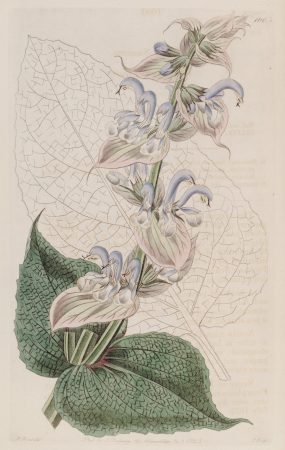
Clary Sage is also known as Salvia sclarea L./Botanical drawing stock image
Some say it hints of ambergris, for others it is the smell of tobacco. It is dryly herbaceous but sweetly so, it may be a bit floral, definitely with hints of tea or balsam, but also completely unique. Clary sage is one of those essential oils that makes itself known as soon as you open the bottle, filling the room with its fragrance. Somewhere in that complex and unique fragrance is the scent of euphoria. If we climb the family tree we find that clary sage is in the mint family, Lamiaceae, which may have been named after the mythical creatures called Lamia, monstrous women with hindquarters of a serpent or beast who devoured children and young men. Going higher we find that it is also a sage and a member of the genus Salvia, possibly from the Latin salvere which means to be well and healthy. The species name is sclarea, again from Latin, and meaning clear. Its use in medicines goes back to Pliny the Elder and Dioscorides in the 1st century and it has a long history of clearing and healing sore eyes.
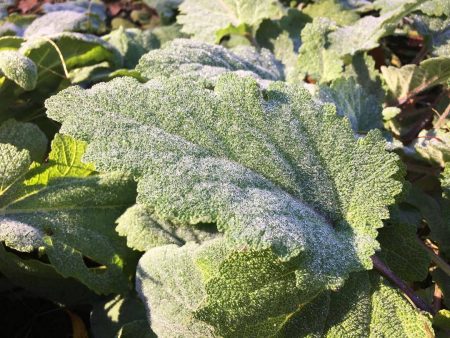
Trueloveseeds.com
With long and hairy leaves, the plant grows to 3-4 feet with stems that are square and also hairy. Flowers are borne in long colorful bracts with a uniquely-shaped sage-type flower. Clary sage is native to areas of the northern Mediterranean, North Africa, and central Asia but is cultivated in central Europe, Russia, England, Italy, Morocco, and North America.
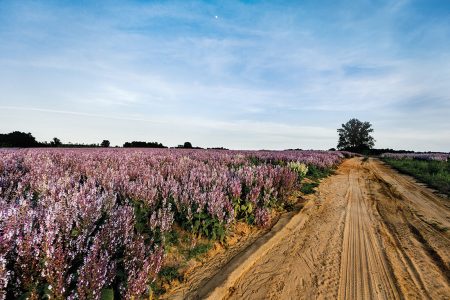
Photo by Charles Harris ourstate.com
In North America, clary sage is grown for distillation in the Northwest and in North Carolina. The story of production in coastal North Carolina goes back to the 1950’s and the tobacco company, R.J. Reynolds and the formation of a cartel in the tobacco-producing countries of Eastern Europe. These countries produced the aromatic variety called Oriental tobacco and had formed the cartel with the goal of controlling, and potentially raising, the price of their product. Researchers at R.J. Reynolds discovered that a constituent of clary sage, sclareol, is the precursor of a compound, sclareolide that was an important flavor ingredient in Asian tobacco. Hoping to reduce their dependence on suppliers, R.J. Reynolds went into the clary sage business. Fields of pink flowers in northeastern North Carolina still produce both the essential oil and sclareol, which is extracted from the spent material after distillation. The sclareol is chemically manipulated into sclareolide—a precursor for ambergris substitutes like Ambrox which are critical to modern perfumery both as fixatives and to add complex nuances of wood, tobacco, oakmoss, and ambergris.
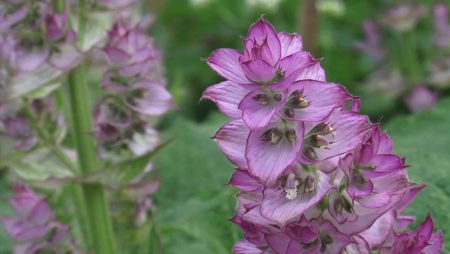
via shutterstock
Fields of pink clary sage flowers are dramatic, fragrant, and lovely in bloom but some don’t appreciate the fragrance and use descriptions ranging from dirty socks to stinky armpits and dead things. However, take those flowering tops, include a few leaves, distill them, and you may find the characteristic aroma of a dry sweet herb, tea, good wine, tobacco, and ambergris.
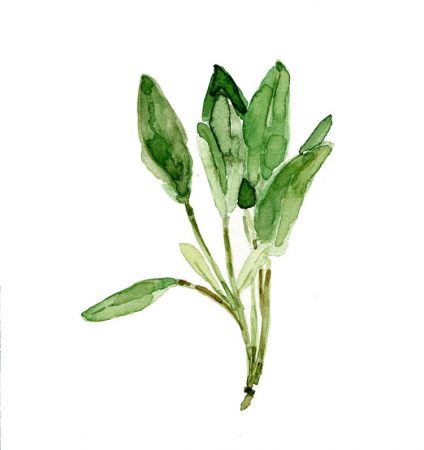
via shutterstock
Solvent extraction produces an absolute of clary sage. The absolute can be quite different from the essential oil, lacking some of the strange herbal notes and exhibiting a complex blend of balsam, tobacco, hay, sweet floral, and ambergris. It adds interest for perfumes, especially where a touch of rich and natural green is called for, and is also an excellent fixative. Also known as Muskateller Salbeiol (muscatel sage oil) clary sage is used in European wines, liqueurs and vermouths for its unique flavor. Sage ale was a popular brew in the Middle Ages, being quite intoxicating but generally leaving one with a severe headache the next day. We now know clary sage also has euphoric effects and should not be used before driving or operating machinery. It should definitely not be combined with alcohol, thus perhaps the headaches and severe intoxication.
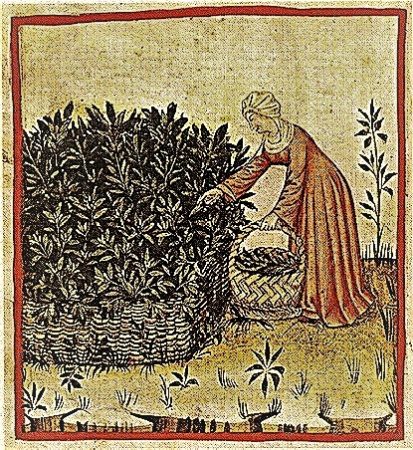
Gathering clary sage in the Middle Ages via wiki
The leaves of the plant may be used in flavoring foods, especially soups and stews, or dipped in batter and fried to make fritters. Tiny amounts of the essential oil may also enhance some fruity flavors as well as tea and rum. Clary sage can balance both female and male hormones, and is often used for PMS issues. It is good for skin and hair, it may reduce blood pressure, and aid in concentration. Historically the thick mucilage from the seeds has been used to clear the eyes of irritating objects. Spiritually and mentally it may help bring about clarity, strengthen memory, assist in vivid dreaming and dream recall, and may even bring about prosperity.
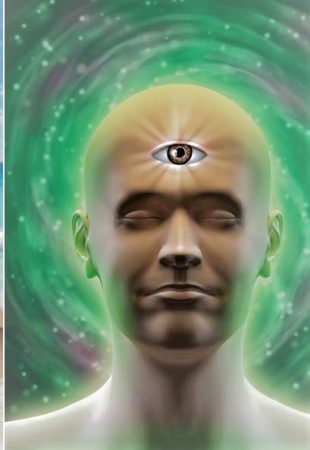
stock photo
Clary sage can be inspirational and uplifting, fighting depression and paranoia, and occasionally working its aphrodisiacal magic. Just as the physical eye may be cleared, the third eye may also be clarified by the essential oil prior to spiritual workings.
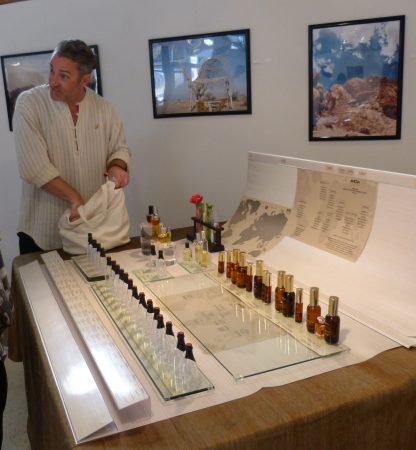
Daniel at FRAGments with “AVEDA: The Early Pure-Fumes 1986-1996.” Photo by Ellen Covey
Daniel Krasofski, who has studied clary sage in the context of aromatherapy, perfumery, and art has this to say about both the essential oil and the absolute:
“As an essential oil, AVEDA used it in many formulations for its therapeutic and psychological. One of my favorite AVEDA products, and long since discontinued, was part of the Futurity line of massage and bath products called “Relax Total Body Compound” oil. Relax was a velvety, spicy aroma that assisted in calmly soothing the body and mind. The key essential oils were anise, sandalwood and clary sage. For over a decade, Clary Sage essential oil was part of my Individualized Accords at Ona Spa in Hollywood. “Emotional Balance” accord included Clary Sage, organic Orange, Cedarwood, organic Geranium and organic Lavender essential oils in a base of avocado, coconut and jojoba oils.
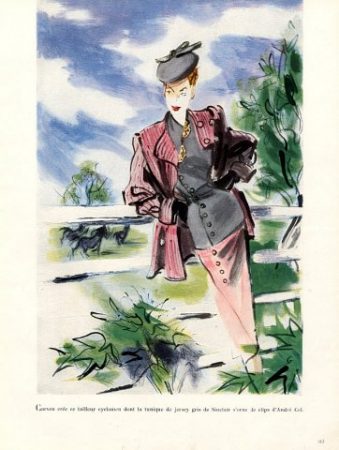
Vintage ad of Ma Griffe circa 1947
In perfumery, Clary Sage Absolute is a great modifier ingredient in fragrance families such as Chypre, Fougere, Aldehydics, Colognes, Oriental, Amber Perfumes as well as fine soaps. In small quantities it could be found in classic perfumes like Shalimar, Fougere Royale, Obsession, Youthdew and Mitsouko. According to the master perfumer Jean Carles, Clary Sage is effective in Chypre accords, most likely it was included in his brilliant perfume of yesteryear Ma Griffe.”
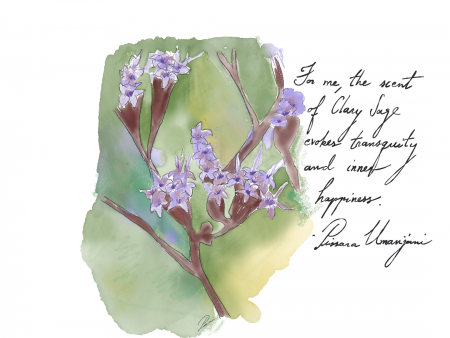
Illustration by Pissara Umavijani of Parfums Dusita
Use it for its ability to evoke tranquility, appreciate its nuances of tobacco, hay, herbs, and flowers, open your third eye, sniff it out in vintage and artisan perfumes, and fall in love with the herb that is clary sage.
Elise Pearlstine—Editor and Natural Perfumer for Tambela
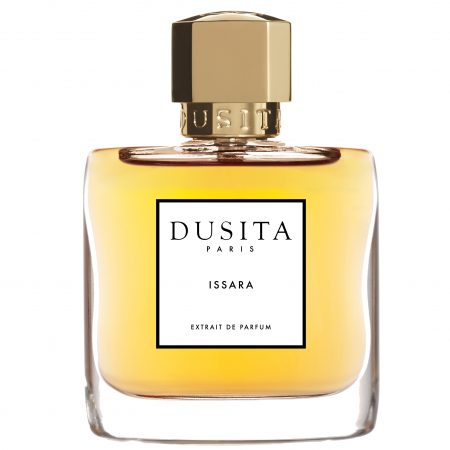
Dusita Paris Issara Extrait courtesy of Dusita
Thanks to award winning artisan perfumer Pissara Umavijani of Parfums Dusita we have a draw worldwide.
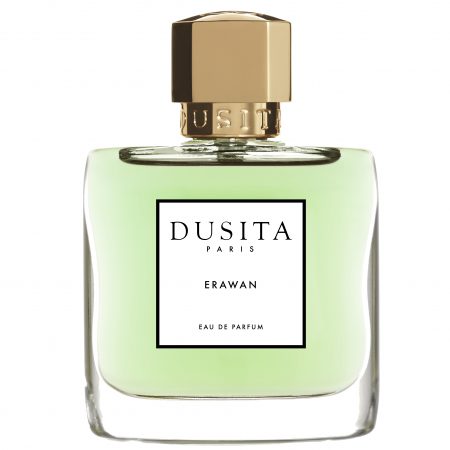
Erawan photo courtesy of Dusita
To be eligible please leave a comment with what you learned about Clary Sage in Perfumery, which Parfums Dusita Fragrance (Issara or Erawan, both use very high percent of clary sage) you would like to win and where you live. The draw is for registered readers only, so be sure to register if you have not done so. Draw closes 11/17/ 2020
Follow us @cafleurebon @elisepearlstine @parfumsdusita @ploiuma @d_krasofski
We announce the winners only on site and on our Facebook page, so Like ÇaFleureBon and use our Blog feed…or your dream prize will be just spilled perfume
This is our Privacy and Draw Rules Policy
